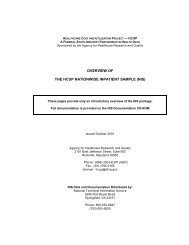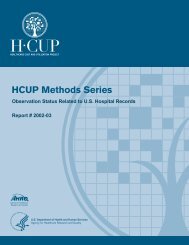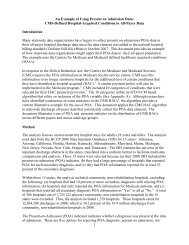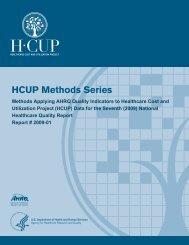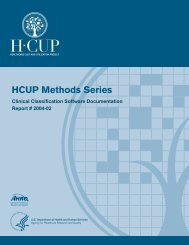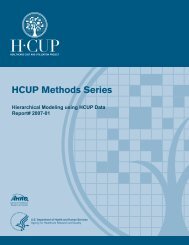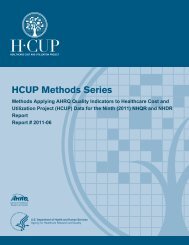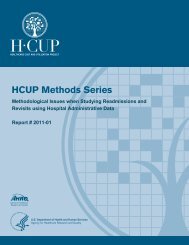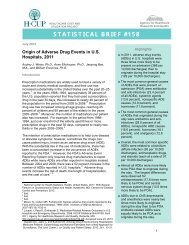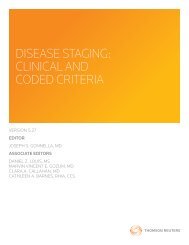Introduction to the HCUP Nationwide Inpatient Sample (NIS)
Introduction to the HCUP Nationwide Inpatient Sample (NIS)
Introduction to the HCUP Nationwide Inpatient Sample (NIS)
Create successful ePaper yourself
Turn your PDF publications into a flip-book with our unique Google optimized e-Paper software.
for calculating statistics based on specific sampling designs. STATA and SUDAAN are two<br />
o<strong>the</strong>r common statistical software packages that perform calculations for numerous statistics<br />
arising from <strong>the</strong> stratified, single-stage cluster sampling design. Examples of <strong>the</strong> use of SAS,<br />
SUDAAN, and STATA <strong>to</strong> calculate <strong>NIS</strong> variances are presented in <strong>the</strong> special report,<br />
Calculating <strong>Nationwide</strong> <strong>Inpatient</strong> <strong>Sample</strong> Variances. This report is available on <strong>the</strong> <strong>HCUP</strong>-US<br />
Website at http://www.hcup-us.ahrq.gov/db/nation/nis/nisrelatedreports.jsp. For an excellent<br />
review of programs <strong>to</strong> calculate statistics from survey data, visit <strong>the</strong> following Website:<br />
http://www.hcp.med.harvard.edu/statistics/survey-soft/.<br />
The <strong>NIS</strong> database includes a Hospital Weights file with data elements required by <strong>the</strong>se<br />
programs <strong>to</strong> calculate finite population statistics. The file includes hospital identifiers (Primary<br />
Sampling Units or PSUs), stratification data elements, and stratum-specific <strong>to</strong>tals for <strong>the</strong><br />
numbers of discharges and hospitals so that finite-population corrections can be applied <strong>to</strong><br />
variance estimates.<br />
In addition <strong>to</strong> <strong>the</strong>se subroutines, standard errors can be estimated by validation and crossvalidation<br />
techniques. Given that a very large number of observations will be available for most<br />
analyses, it may be feasible <strong>to</strong> set aside a part of <strong>the</strong> data for validation purposes. Standard<br />
errors and confidence intervals can <strong>the</strong>n be calculated from <strong>the</strong> validation data.<br />
If <strong>the</strong> analytic file is <strong>to</strong>o small <strong>to</strong> set aside a large validation sample, cross-validation techniques<br />
may be used. For example, ten-fold cross-validation would split <strong>the</strong> data in<strong>to</strong> ten subsets of<br />
equal size. The estimation would take place in ten iterations. In each iteration, <strong>the</strong> outcome of<br />
interest is predicted for one-tenth of <strong>the</strong> observations by an estimate based on a model fit <strong>to</strong> <strong>the</strong><br />
o<strong>the</strong>r nine-tenths of <strong>the</strong> observations. Unbiased estimates of error variance are <strong>the</strong>n obtained by<br />
comparing <strong>the</strong> actual values <strong>to</strong> <strong>the</strong> predicted values obtained in this manner.<br />
Finally, it should be noted that a large array of hospital-level data elements are available for <strong>the</strong><br />
entire universe of hospitals, including those outside <strong>the</strong> sampling frame. For instance, <strong>the</strong> data<br />
elements from <strong>the</strong> AHA surveys and from <strong>the</strong> Medicare Cost Reports are available for nearly all<br />
hospitals in <strong>the</strong> U.S., although hospital identifiers are suppressed in <strong>the</strong> <strong>NIS</strong> for a number of<br />
States. For <strong>the</strong>se States it will not be possible <strong>to</strong> link <strong>to</strong> outside hospital-level data sources. To<br />
<strong>the</strong> extent that hospital-level outcomes correlate with <strong>the</strong>se data elements, <strong>the</strong>y may be used <strong>to</strong><br />
sharpen regional and nationwide estimates.<br />
As a simple example, <strong>the</strong> number of Cesarean sections performed in each hospital would be<br />
correlated with <strong>the</strong>ir <strong>to</strong>tal number of deliveries. The figure for Cesarean sections must be<br />
obtained from discharge data, but <strong>the</strong> number of deliveries is available from AHA data. Thus, if<br />
a regression model can be fit predicting this procedure from deliveries based on <strong>the</strong> <strong>NIS</strong> data,<br />
that regression model can <strong>the</strong>n be used <strong>to</strong> obtain hospital-specific estimates of <strong>the</strong> number of<br />
Cesarean sections for all hospitals in <strong>the</strong> AHA universe.<br />
Longitudinal Analyses<br />
Hospitals that continue in <strong>the</strong> <strong>NIS</strong> for multiple consecutive years are a subset of <strong>the</strong> hospitals in<br />
<strong>the</strong> <strong>NIS</strong> for any one of those years. Consequently, longitudinal analyses of hospital-level<br />
outcomes may be biased, if <strong>the</strong>y are based on any subset of <strong>NIS</strong> hospitals limited <strong>to</strong> continuous<br />
<strong>NIS</strong> membership. In particular, such subsets would tend <strong>to</strong> contain fewer hospitals that opened,<br />
closed, split, merged, or changed strata. Fur<strong>the</strong>r, <strong>the</strong> sample weights were developed as<br />
annual, cross-sectional weights, ra<strong>the</strong>r than longitudinal weights. Therefore, different weights<br />
might be required, depending on <strong>the</strong> statistical methods employed by <strong>the</strong> analyst.<br />
<strong>HCUP</strong> <strong>NIS</strong> (09/06/2011) 17 <strong>Introduction</strong>



